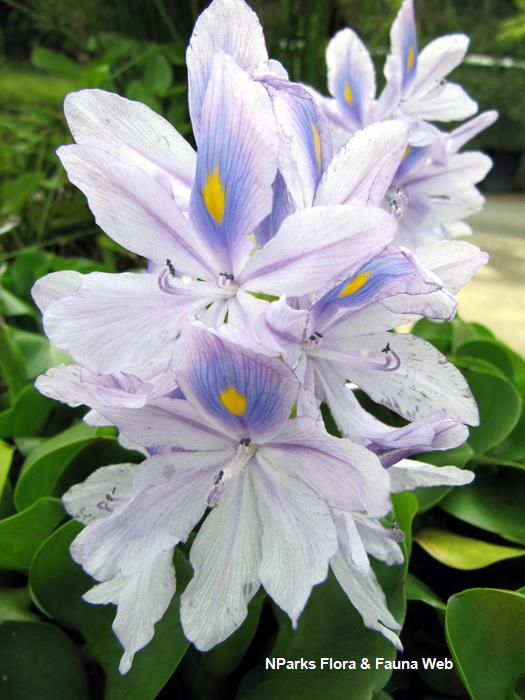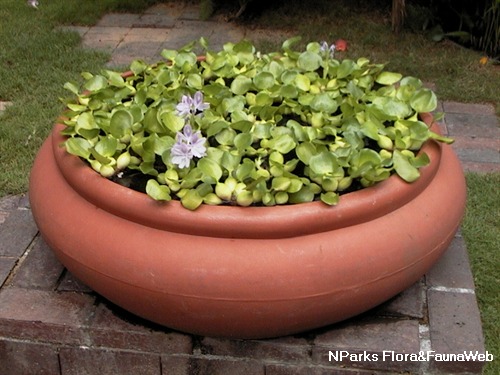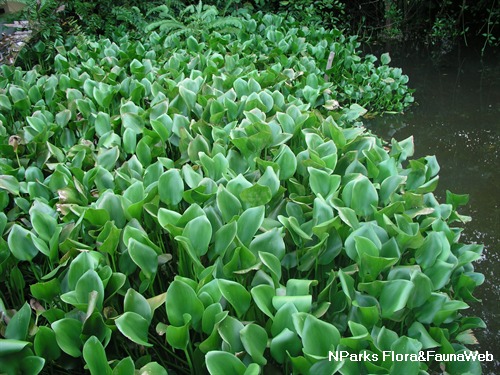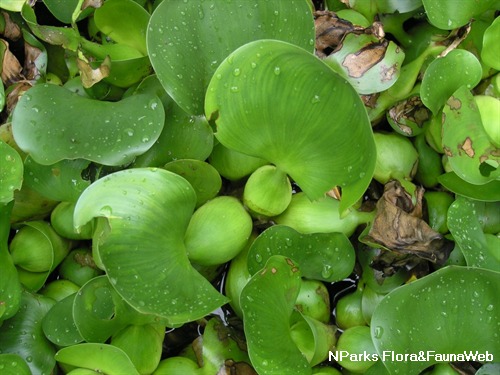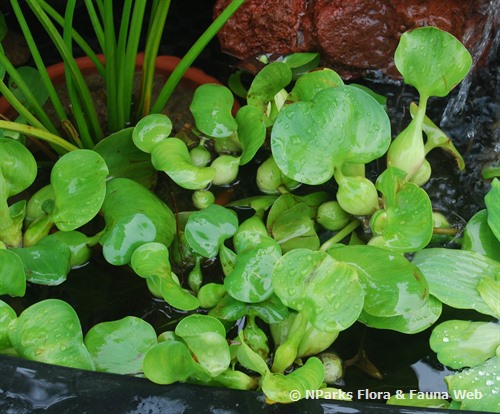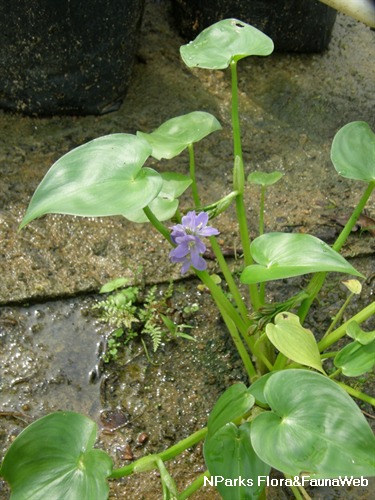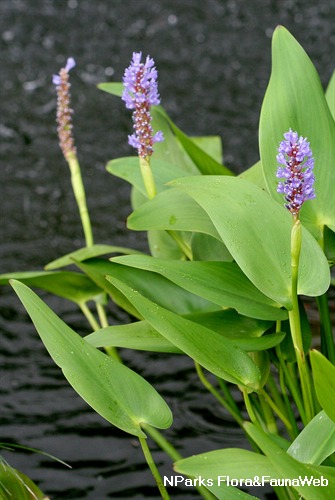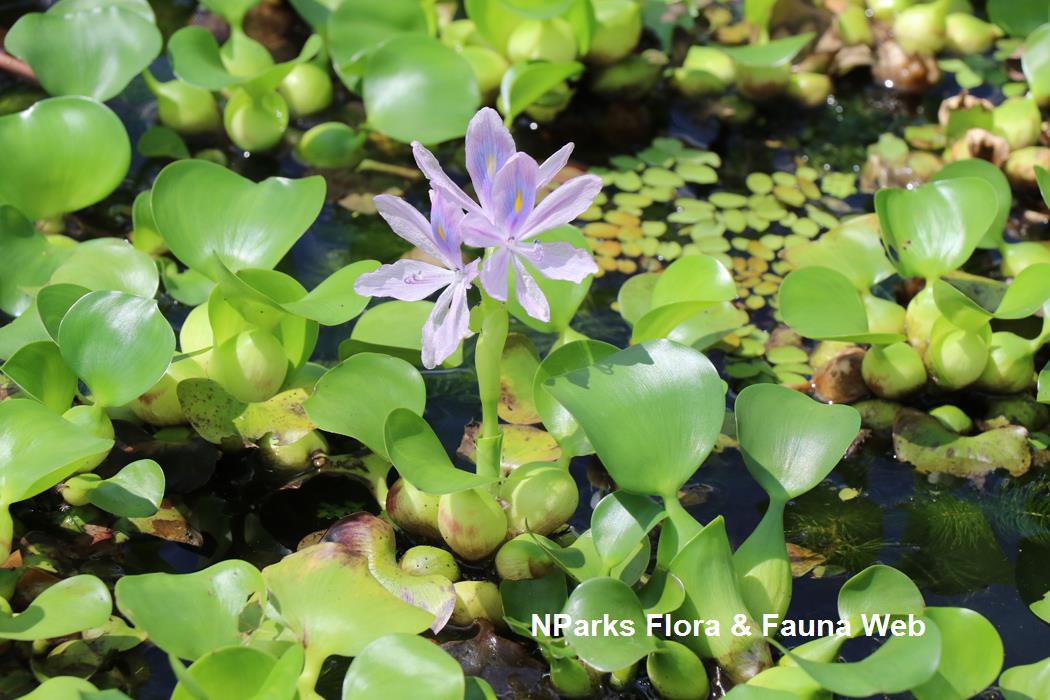
Back
Pontederia crassipes Mart.
| Family Name: | Pontederiaceae |
| Synonyms: | Eichhornia crassipes (Mart.) Solms, Eichhornia crassicaulis Schltdl., Pontederia elongata Balf. |
| Common Name: | Water Hyacinth, Lilac Devil, Keladi Bunting, Kemeling Telur, 凤眼蓝 |
Although Water Hyacinth produces lovely flowers, it is considered a problematic invasive species in many parts of the world. It quickly forms a dense mat of foliage that blocks light from penetrating the water, preventing photosynthesis by algae, and thus decreasing oxygen content in the water. This alteration of the environment can displace native species.
Name
Classifications and Characteristics
| Plant Division | Angiosperms (Flowering Seed Plants) |
|---|---|
| Plant Growth Form | Aquatic & Hydrophyte (Floating Aquatic), Herbaceous Plant |
| Lifespan (in Singapore) | Perennial |
| Mode of Nutrition | Autotrophic |
| Maximum Height | 30 cm to 65 cm |
Biogeography
| Native Distribution | Southern Tropical America |
|---|---|
| Native Habitat | Aquatic |
| Preferred Climate Zone | Tropical |
| Local Conservation Status | Non-native (Spontaneous (Naturalised)) |
| CITES Protection | False |
Description and Ethnobotany
| Growth Form | Free-floating, aquatic plant typically reaching up to 0.3 - 0.65 m, but occasionally up to 1 m. |
|---|---|
| Roots | Fibrous roots are long and feathery. |
| Foliage | Large, roundish leaves are slightly cupped, smooth and glossy with entire leaf margin. The ball-shaped leaf stalk at the base of the leaf is filled with spongy tissue that helps to keep the plant afloat. |
| Stems | Water Hyacinth produces stolons, underwater stems that connect the parent plant to its genetically identical progeny. |
| Flowers | Light purple to blue flowers are arranged on a spike inflorescence. The top petal has a yellow, oval-shaped center surrounded by distinct, dark purple lines that originate from the base, radiate outwards and branch toward the middle and outer edges of the petal. The inflorescence perched on a long stalk can reach up to 0.6 m tall. |
| Fruit | Fruit is a capsule that contains 3 compartments filled with small, ribbed seeds. |
| Cultivation | This species can be grown in soil or water. The leaf stalk will be short and round in water, but long and thin in soil. |
| Ethnobotanical Uses | Edible Plant Parts : Edible Leaves Food (Fruit or Vegetable): The leaves are edible and may be eaten raw in salads, steamed or cooked in soups. Others: In rural areas, the leaves are used as pig feed. It has strong phytoremediation potential, because it absorbs many types of pollutants, such as lead, zinc, nickel, mercury, chromium, and arsenic. It also absorbs the nutrients nitrogen and phosphorous which are detrimental to the environment at excess levels. Research is being conducted on using this plant to treat sewage waste. In Cambodia, the leaf stalks are dried and weaved together to make various products, like baskets and table mats. |
Landscaping Features
| Desirable Plant Features | Ornamental Flowers |
|---|---|
| Landscape Uses | Pond / Lake / River, Phytoremediation |
Fauna, Pollination and Dispersal
| Fauna Pollination Dispersal Associated Fauna | Bee-Attracting |
|---|---|
| Pollination Method(s) | |
| Seed or Spore Dispersal | Abiotic (Gravity, Water) |
Plant Care and Propagation
| Light Preference | Full Sun |
|---|---|
| Water Preference | Lots of Water |
| Plant Growth Rate | Very Fast |
| Propagation Method | Seed, Stolon / Runner |
Foliar
| Foliage Retention | Evergreen |
|---|---|
| Mature Foliage Colour(s) | Green |
| Mature Foliage Texture(s) | Smooth |
| Foliar Type | Simple / Unifoliate |
| Foliar Arrangement Along Stem | Rosulate / Rosette |
| Foliar Shape(s) | Non-Palm Foliage (Orbicular / Round) |
| Foliar Venation | Parallel |
| Foliar Margin | Entire - Wavy / Undulate |
| Foliar Apex - Tip | Rounded |
| Foliar Base | Rounded / Obtuse |
| Leaf Area Index (LAI) for Green Plot Ratio | 3.5 (Shrub & Groundcover - Monocot) |
Floral (Angiosperm)
| Flower & Plant Sexuality | Bisexual Flowers |
| Flower Colour(s) | Purple, Blue |
|---|---|
| Flower Texture(s) | Smooth |
| Flower Grouping | Cluster / Inflorescence |
| Flower Location | Terminal |
| Flower Symmetry | Bilateral |
| Individual Flower Shape | Stellate / Star-shaped |
| Inflorescence Type | Spike |
Fruit, Seed and Spore
| Fruit Classification | Simple Fruit |
|---|---|
| Fruit Type | Dehiscent Dry Fruit , Capsule |
| Mature Seed Texture(s) | Ridged / Corrugated |
References
| References | Yong J, Tan PY, Nor Hafiz Hassan, Tan SN. 2010. A Selection of Plants for Greening of Waterways and Waterbodies in the Tropics. Singapore: Chung Printing . 480 pp. |
|---|
Image Repository
Others
| Master ID | 689 |
|---|---|
| Species ID | 1984 |
| Flora Disclaimer | The information in this website has been compiled from reliable sources, such as reference works on medicinal plants. It is not a substitute for medical advice or treatment and NParks does not purport to provide any medical advice. Readers should always consult his/her physician before using or consuming a plant for medicinal purposes. |

